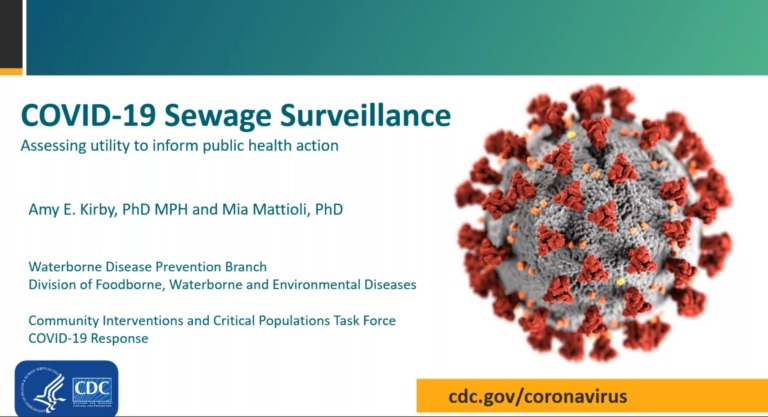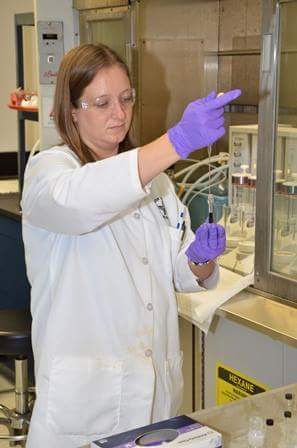From the Water Environment Federation…
Studying concentrations of pathogens in wastewater — a practice known as wastewater-based epidemiology (WBE) — is a time-honored approach to gathering crucial public health data that traditional approaches might miss. During the coronavirus pandemic, the U.S. Centers for Disease Control and Prevention (CDC) are partnering with the U.S. Environmental Protection Agency (EPA) to establish a formalized, federal-led approach to WBE over the next 18 months.

The Water Environment Federation (WEF; Alexandria, Virginia) held a webcast July 15 discussing the first federal government-led wastewater-based epidemiology (WBE) effort in the U.S. The webcast featured scientists from the U.S. Centers for Disease Control. Click here to listen to the webcast.
The Water Environment Federation (WEF; Alexandria, Virginia) held a webcast on July 15 to explore this partnership. CDC staff discussed the initiative’s goals, anticipated format, and timeline, as well as how WBE could represent a critical tool for coronavirus response efforts. Dr. Amy Kirby and Dr. Mia Mattioli, both representing the CDC Waterborne Disease Prevention Branch, participated in the discussion, moderated by WEF Senior Director of Government Affairs Claudio Ternieden.
“WEF has pulled this together as a way to start the process of informing folks out there on what is being coordinated by CDC and EPA in terms of a wastewater-based epidemiology program,” Ternieden said. “Going forward, WEF would like to work very closely with CDC, EPA, and other partners to make sure such a program is productive and valuable.”
Although typically the focus of isolated research studies rather than sector wide standards, the WBE concept has been in use for decades to study infectious diseases such as polio, as well as to track the extent of the U.S. opioid epidemic.
In the case of coronavirus, an organized approach to WBE could provide useful insights for public health professionals, Kirby explained. Many COVID-19 patients are asymptomatic, may not see a doctor, or may not have access to a COVID-19 test. However, existing data suggests as many as 80% of infected people pass on traces of the virus that causes COVID-19 through their waste. Influent samples from water resource recovery facilities (WRRFs), then, might provide more accurate estimates of local cases.
“To be very clear, sewage surveillance cannot replace clinical surveillance, but we think it can provide another data source for decision-making,” Kirby said. “This is a science that’s still developing, and we have a lot yet to learn, but we are gathering data quickly and we think this approach has great promise.”
Kirby also described that WBE may be able to provide earlier warnings of impending infection spikes. CDC currently estimates that high detections in wastewater of the virus that causes COVID-19 generally correlate with confirmed cases about 4 to 6 days in the future. Typical clinical procedures may take two weeks or more. These early warnings could be of particular use in high-risk facilities such as nursing homes, university campuses, and prisons, Kirby said. WBE also could help identify promising treatment strategies more quickly, such as when local changes in clinical procedures correspond with lower virus concentrations in wastewater.
Limitations to the WBE approach exist, however. For one, Kirby and Mattioli discussed that not enough data on the virus’ transmission through waste are yet available to ensure data quality. Communities served by decentralized wastewater systems – as well as about 25% of U.S. residences that are not connected to collections system at all – are also not represented in data gathered for WBE.
Webcast speakers noted that while traces of the virus that causes COVID-19 have been detected in wastewater, no evidence yet suggests that these traces are infectious, or that water and wastewater workers exhibit higher COVID-19 infection rates than the general public. The current CDC guidance states that “standard practices associated with wastewater treatment plant operations should be sufficient to protect wastewater workers from the virus that causes COVID-19.” Further, EPA states that the virus that causes COVID-19 “is a type of virus that is particularly susceptible to disinfection. Standard treatment and disinfectant processes at wastewater treatment plants are expected to be effective.”
CDC is in the early stages of a partnership with EPA and other federal agencies to establish the National Wastewater Surveillance System (NWSS), the first government-led WBE program in the U.S.

WBE is an approach to public health monitoring that is growing in prevalence around the world, finding applications in such issues as tracking infectious diseases and narcotics use. While WBE cannot replace traditional clinical surveillance, webcast speakers discussed how WBE can offer useful insights that are difficult or impossible to glean from conventional methods. Image courtesy of Ashley Wolfe/City of Arlington, Texas
NWSS would begin with a network of partnering WRRFs and laboratories, which WEF would help coordinate. WRRF staff would collect influent samples at least 1 to 2 times each week and ship them overnight to participating laboratories. Laboratory staff would analyze and process samples from multiple WRRFs in their region and send the data to CDC. CDC would then ensure data integrity, aggregate the data, and draw conclusions before sharing findings with local and state governments, international health groups, hospitals, and the public.
Mattioli described one of CDC’s top priorities is to fine-tune best-practice procedures for sampling and analysis. A growing number of U.S. states already have WBE-based data pertaining to coronavirus, but current procedures are unstandardized and difficult to compare. During the coming months, Mattioli said, CDC will develop best practices for wastewater sample collection and handling procedures, data collection and quality control measures, and data normalization strategies. CDC and EPA also will develop a wastewater detection limit for the virus that causes COVID-19.
“While sewage data has a clear potential to be a promising tool for COVID-19 response, this tool can only be useful for public health if it consists of robust and high-quality data,” Mattioli said. “CDC is working to tackle these big data quality issues working closely with our federal partners at EPA to leverage their expertise in environmental sampling and testing protocols … for disease surveillance under the different states of the epidemiological curve.”
After establishing an inaugural group of participating WRRFs and laboratories and developing best practices, Kirby said the next phase of the program’s development will involve working more closely with EPA and WEF to formalize procedures into standard methods, and to expand the network to represent communities nationwide. The complete NWSS is projected to be in operation within 18 months.
“We know that the scale and speed of this [COVID-19] response is really pushing public health capacity to its limit, so CDC wanted to take a methodical, evidence-based approach to evaluating sewage surveillance before we move forward with implementing it,” Kirby said. “We recognize that we’re building this boat as we’re sailing it, and so we’ll continue to evaluate the system performance and application to the response.”